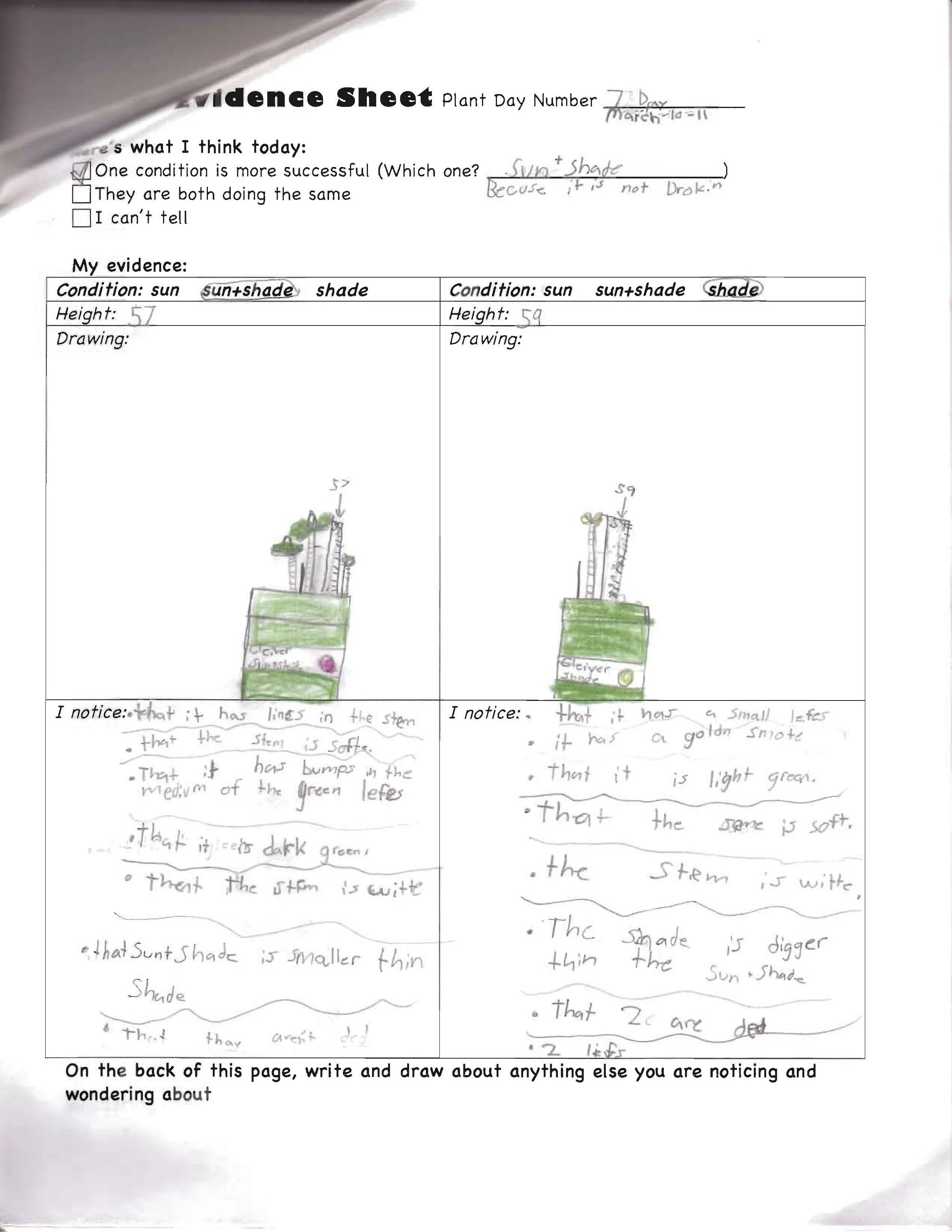How to define attributes
Scientists have to specify the attributes they care about and describe what they see so that others see the same thing. This often includes asking, “What do we mean by...” (e.g., size, force, health) and differentiating or bounding attributes. Engaging students in the work of specifying what they mean, and trying to understand what others mean, provides a context for engaging with each other’s ideas and helps them develop more specific descriptions of important attributes.
A closer look at uncertainty in the classroom
Third grade students are on their seventh day of an investigation to explore whether light matters for the growth of seeds landing in a wild backyard area behind their school. To investigate, they placed Wisconsin Fast Plant seeds in three conditions designed to represent the conditions in the backyard. As Charles presents his findings, the question arises, What does he mean when he says the plants in the shade condition are bigger? You will see uncertainty about how to define “bigness” emerge and support science practice and conceptual progress as:
Charles supports a claim with evidence
Brady questions what he means when he says the shade plants are bigger
Students use the newly differentiated attributes to strengthen their claims and evidence
Charles supports a claim with evidence
Charles’s evidence sheet
Students brainstormed how they would know their plants were successful and included attributes such as height, leaves, color, and flowers on their list of potential evidence. Each child observed two pots several times per week, noting their thinking and observations on their evidence sheet. On Day 7, Charles recorded several different observations on his evidence sheet. These included the height of the plants; the color; characteristics of the leaves such as color, number, and size; and whether they are dead or broken. He concluded that the plants in the sun + shade condition (with a light on them 7 hours a day) were more successful.
Brady questions what Charles means when he says the shade plants are bigger
Brady points at the bumps.
After Charles presented, Brady raised his hand.
Brady: What do you mean by the shade is bigger?
Charles: The shade- the pod of the shade is bigger.
Mrs. W: The pod is?
Charles: The plant.
Azhad: The shade is bigger than the sun and shade (Reading from the evidence sheet).
Brady: Are there bumps on the shade? Is there a bump right here? (Points to the bump on the drawing on sun plus shade)
Teachers then support Brady and Charles to tell what they are thinking about when they are deciding which plant is bigger. Charles says that he was thinking that the plants in the shade are taller, while Brady was thinking that the plants in the sun + shade were thicker and had bigger leaves.
Students use the newly differentiated attributes to strengthen their claims and evidence
Mrs. W: I’ve heard other people who used the height of their plants as being more successful because their plants were growing taller but Charles, he's saying to me that he thinks this one (uses pointer to point to sun + shade drawing projected on board) is more successful with sun and shade but the heights (points up to where height is written on student sheet) this one (sun + shade) is shorter than this one (shade), right? Hmm... So is that different than what some people think as their evidence? Was the height- they were using the height as their evidence. But Charles, you didn't really use the height as your evidence did you?
Malik: Umm...everybody who has the sun, their plant is SHORT but it's really...thicker (gestures out) than the ones who have the shade.
Azhad: I know, right?
Malik: The shade is tall (gestures upwards) but isn't growing well.
Mrs W: So the shade ones you see are tall but they're not growing as successfully.
Instructional moves to support this form of uncertainty
Regularly asking questions like, “What do you mean by…” as students are presenting or sharing evidence.
Having materials and student representations available as students are sharing evidence. This helps audience members see an attribute in a different way.
Listening for students’ “what do you mean” questions and providing support to unpack them.
Keeping visual and tactile representations of attributes visible in the classroom and engaging students in developing and refining these. For example, you might develop a “properties of materials” chart with materials that are rough, smooth, and soft taped to them or develop a chart with different size terms (height, width, volume, weight) that includes pictures and units.
Where else does this form of uncertainty come up?
Explore Related Cases
Other Ways to Learn More
Explore the Claims and Evidence Conversation Tool to consider how investigators move from observations to evidence.
Read Chapter 6 of our book, Productive Uncertainty in Science Education, to learn more about supporting students to develop and talk about observations from investigations.




